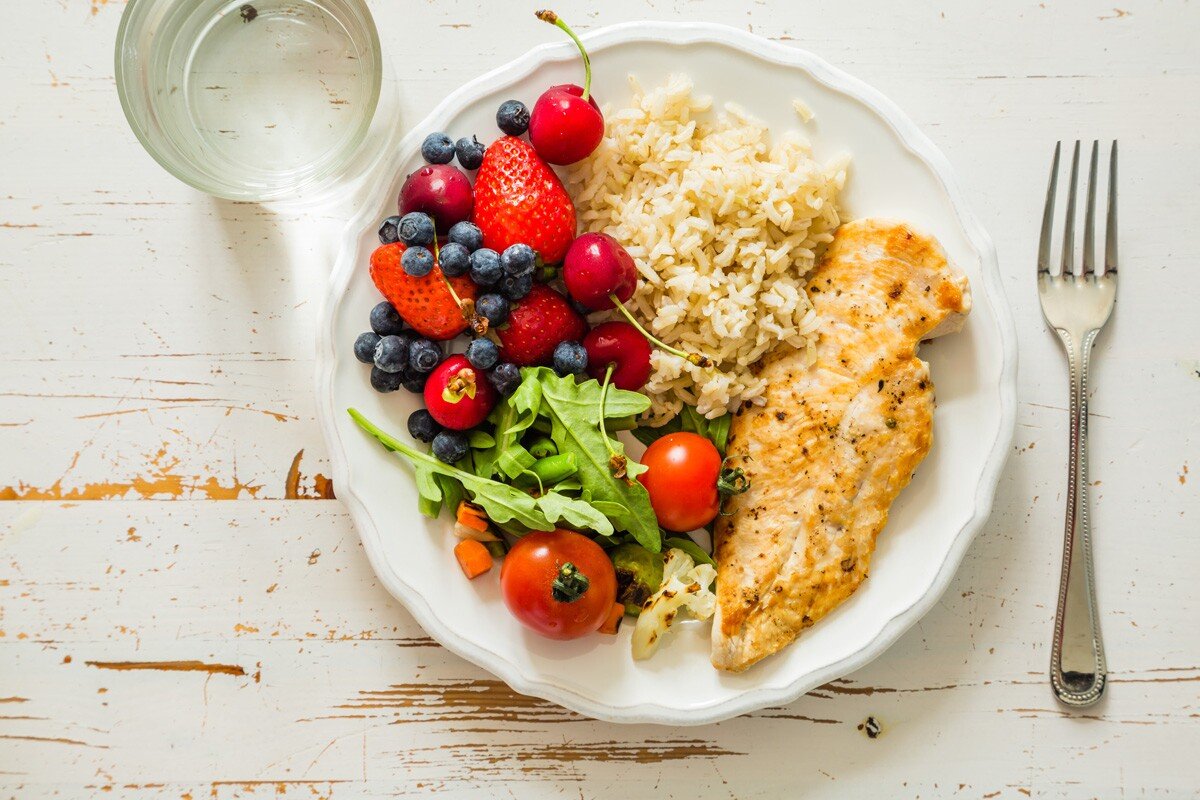Are you struggling to lose weight despite eating healthy foods? The secret might not just be what you eat, but how much you eat.
Portion control plays a powerful role in your weight loss journey. Understanding how the size of your meals affects your body can help you shed pounds faster and keep them off. If you’ve ever wondered why some diets don’t work, it’s time to discover how mastering portion control can change everything for your health and confidence.
Keep reading to find out how small changes on your plate can lead to big results for your weight loss goals.
Role Of Portion Control In Weight Loss
Portion control means eating the right amount of food for your body. It helps you lose weight by managing how much you eat.
Eating smaller portions can reduce calorie intake and stop you from gaining weight. It helps you stay on track with your weight loss goals.
Calorie Intake And Portion Sizes
Calories are units of energy from food. Eating too many calories can cause weight gain. Portion control helps keep calories in check.
By eating smaller portions, you take in fewer calories. This creates a calorie deficit, which is needed for weight loss.
- Smaller portions reduce calorie intake
- Helps prevent eating extra calories
- Makes it easier to track calories
Impact On Metabolism
Portion control affects how your body burns calories. Eating moderate portions keeps your metabolism steady.
Large meals can slow metabolism and cause fat storage. Small, balanced portions help your body use energy better.
- Moderate portions support healthy metabolism
- Helps maintain steady energy use
- Prevents slow metabolism from overeating
Avoiding Overeating
Portion control stops you from eating too much at once. Overeating adds extra calories and can lead to weight gain.
Using smaller plates and measuring food helps control portions. This makes it easier to avoid eating more than your body needs.
- Prevents eating beyond fullness
- Helps recognize true hunger
- Reduces mindless snacking

Common Portion Control Mistakes
Portion control is important for weight loss. Many people make mistakes that affect their results. Understanding these mistakes helps you eat better.
Here are common portion control errors and how they impact your eating habits.
Underestimating Serving Sizes
People often think their portions are smaller than they really are. This leads to eating more calories than planned. Packages and plates can trick your eyes.
Using measuring cups or food scales helps avoid this mistake. Knowing exact serving sizes improves portion control.
- Eating two servings instead of one by accident
- Filling plates too full without measuring
- Ignoring nutrition labels on packaged foods
Ignoring Hunger Cues
Many people eat even when they are not hungry. This can cause overeating and weight gain. Learning to listen to your body is key.
Stop eating when you feel satisfied, not stuffed. Pay attention to feelings of hunger and fullness during meals.
- Eating out of boredom or stress
- Eating quickly without noticing fullness
- Confusing thirst with hunger
Mindless Eating Triggers
Distractions like watching TV can cause you to eat more than needed. Mindless eating makes portion control hard. Focus on your food to avoid this.
Set aside time to eat without distractions. This helps you recognize when you are full and stop eating on time.
- Eating while using a phone or computer
- Snacking directly from large containers
- Eating because food is available, not because you are hungry
Effective Portion Control Strategies
Portion control helps manage how much food you eat. It can support weight loss by reducing calorie intake.
Using simple strategies makes portion control easier and more effective for daily meals.
Using Smaller Plates And Bowls
Smaller plates and bowls make portions look bigger. This can trick your brain into feeling full faster.
Using smaller dishware helps reduce the amount of food you serve without feeling deprived.
Measuring Portions Accurately
Measuring food ensures you eat the right amount. It stops you from guessing portions.
Use measuring cups, spoons, or a food scale to get exact portions for meals and snacks.
- Measure grains and pasta before cooking
- Use a food scale for meats and vegetables
- Check serving sizes on food labels
Pre-planning Meals And Snacks
Plan your meals and snacks ahead to control portions better. This helps avoid overeating.
Preparing food in advance lets you portion out servings before you eat.
- Pack snacks in small containers
- Divide meals into single servings
- Create a weekly meal plan with set portions
Behavioral Tips To Support Portion Control
Portion control helps manage how much food you eat. It plays a big role in weight loss. Learning good habits can make portion control easier.
Small changes in behavior help you eat less without feeling hungry. These tips focus on how you eat and your body’s needs.
Eating Slowly And Mindfully
Eating slowly lets your brain know when you are full. It takes time for fullness signals to reach your mind. Mindful eating means paying full attention to your food.
Try to chew well and enjoy every bite. Avoid distractions like TV or phones. This helps prevent overeating and improves digestion.
- Put your fork down between bites
- Focus on flavors and textures
- Eat without rushing
Staying Hydrated
Drinking water helps control hunger. Sometimes, thirst feels like hunger. Drinking water before meals can reduce how much you eat.
Aim to drink water regularly throughout the day. This supports your metabolism and keeps you feeling full longer.
- Drink a glass of water before meals
- Carry a water bottle with you
- Choose water over sugary drinks
Managing Emotional Eating
Emotional eating happens when you eat to feel better, not because you are hungry. It can lead to eating too much. Recognizing emotions helps you control this behavior.
Find other ways to deal with emotions. Try activities like walking, reading, or talking to a friend. This reduces the urge to eat for comfort.
- Keep a journal to track feelings and eating
- Practice deep breathing or meditation
- Set aside time for hobbies and relaxation
Tools And Resources For Portion Control
Portion control is a key part of losing weight. It helps you eat the right amount of food. Using tools can make portion control easier and more accurate.
Many resources exist to help you measure and manage your food portions. These tools guide you to eat less without feeling hungry.
Portion Control Apps
Portion control apps track your food intake and suggest portion sizes. They help you stay aware of how much you eat each day.
Many apps include food databases, meal plans, and reminders. They make it simple to record meals and control portions.
- Track calories and nutrients
- Set daily portion goals
- Receive notifications to eat mindfully
- Log meals quickly with barcode scanners
Food Scales And Measuring Cups
Food scales and measuring cups give exact portion sizes. These tools help you avoid guessing how much you eat.
Using a scale or cups can improve portion control accuracy. They are especially useful for calorie-dense foods like nuts or oils.
- Weigh foods in grams or ounces
- Measure liquids with cups or spoons
- Ensure consistent portion sizes every meal
- Help with meal prep and planning
Visual Portion Guides
Visual portion guides use common objects to show serving sizes. These guides make it easier to estimate portions without tools.
They help you learn portion sizes by sight. This skill improves your ability to control food amounts anywhere.
- A deck of cards equals a 3-ounce meat portion
- A tennis ball matches one cup of vegetables
- A thumb tip shows a tablespoon of oil or butter
- A fist measures about one cup of fruits or grains

Portion Control For Different Diets
Portion control helps manage how much food you eat. It plays a big role in weight loss across many diets.
Each diet needs different portion sizes to work best. Adjusting portions can improve results and keep you healthy.
Low-carb And Keto Approaches
Low-carb and keto diets focus on eating fewer carbs and more fats. Portion control means eating enough fat and protein without extra carbs.
Keep carb portions very small, usually under 20-50 grams a day. Measure fats like oils and nuts to avoid eating too many calories.
- Limit carb portions to vegetables and small fruit servings
- Protein portions should be moderate, like a palm-sized piece
- Fat portions need control; use measured amounts of oils and nuts
Plant-based Diets
Plant-based diets focus on vegetables, fruits, grains, and legumes. Portion control helps avoid eating too many calories from carbs and fats.
Watch portions of starchy foods and nuts. Fill your plate mostly with vegetables to stay full and reduce calorie intake.
- Eat large portions of non-starchy vegetables
- Limit grains and legumes to a fist-sized serving
- Control nuts and seeds to a small handful
Balanced Macronutrient Portions
A balanced diet has carbs, protein, and fats in good amounts. Portion control helps keep these nutrients in the right balance.
Divide your plate with half vegetables, a quarter protein, and a quarter carbs. Measure fats like oils and butter to avoid extra calories.
- Half your plate should be vegetables or salad
- Protein should be about the size of your palm
- Carbs like rice or bread fill one-quarter of the plate
- Use fats like oils sparingly, about one to two tablespoons
Frequently Asked Questions
What Is Portion Control In Weight Loss?
Portion control means managing the amount of food you eat per meal. It helps reduce calorie intake and prevents overeating, supporting effective weight loss.
How Does Portion Control Impact Calorie Intake?
Portion control limits the quantity of food, directly reducing calories consumed. Fewer calories create a calorie deficit, essential for losing weight efficiently.
Can Portion Control Improve Metabolism?
Yes, portion control helps stabilize blood sugar and prevents overeating. This balance supports a healthy metabolism and sustained energy levels during weight loss.
Is Portion Control Better Than Dieting?
Portion control focuses on quantity, making it sustainable long-term. Unlike strict diets, it encourages mindful eating and helps maintain weight loss permanently.
Conclusion
Portion control plays a key role in weight loss. It helps manage calorie intake. Smaller portions mean fewer calories consumed. This can lead to gradual weight loss. Mindful eating supports healthy habits. Focus on hunger cues. Eat slowly. Enjoy each bite.
This aids digestion and satisfaction. Balancing portion sizes with nutritious foods is crucial. Include fruits, vegetables, and proteins in your meals. Stay hydrated. Drink water before meals to feel full. Consistent portion control supports long-term goals. Remember, small changes make a big difference.
Stay committed. Celebrate progress. Your journey to healthier living continues with each mindful meal.



